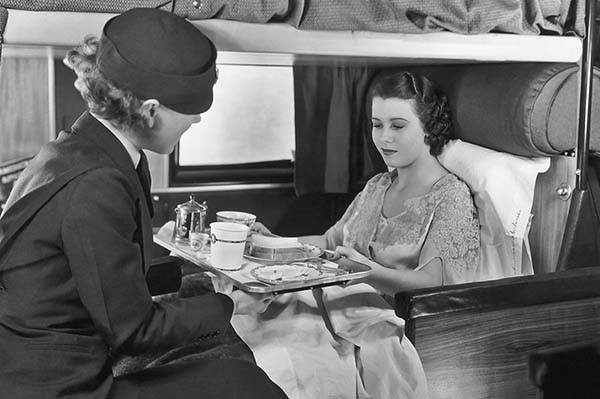
Eight young pioneering women became the first stewardesses–today’s flight attendants. They established a reputation for professionalism and care.
Commercial aviation greatly expanded in the years just after the First World War. At first the fledgling airlines made do with such things as bombers that were converted to civilian use. Eventually new airplanes were developed, equipment like the famous Ford Trimotor and the Boeing 80 and 80A. But commercial aviation was still in its infancy, and for the flying public—what there was of it– the experience was both pricey and dangerous.
The First Flight Attendants
The British Daimler Company used the first cabin attendants in 1922, mostly teenaged boys who didn’t serve food and really contributed little to the passenger’s safety and comfort. In 1926 The Stout Air Service, ironically one of the companies that would make up United Airlines, had young men aboard called “aerial couriers.” They too weren’t really trained, and didn’t contribute much to commercial aviation.
Ellen Church, The First Female Flight Attendant
Ellen Church, a native of Iowa, was the person who began flight attending as we know it today. Church, a licensed pilot, was also a registered nurse. She knew that she didn’t stand a chance being a commercial pilot. Both company executives and male pilots were dead set against the idea of hiring women. Sexual stereotypes were common in the 1920s and 1930s, and most men didn’t think women had the intelligence for such jobs. There was also the feeling that flying was harzerdous, and the last thing a flight crew needed was a “helpless woman” around.
Church managed to convince Steve Stimpson, the manager of Boeing Air Transport (BAT) in San Francisco, that trained female nurses would be an asset as attendants. The early aircraft flew at much lower altitudes than today—some as low as 6.000 feet. That meant air turbulence was all too common, and many passengers became ill. What better than to have a trained nurse aboard to settle stomachs and raise courage? Most flyers were businessmen. If a “girl” could fly, then so could they.
The Original Eight Flight Attendants, 1930
Church was hired, along with seven others. At the time they were called “stewardesses,” a name they would have until the 1970s. The first stewardesses were Ellen Church, Margaret Arnott, Jessie Carter, Ellis Crawford, Harriet Fry, Alva Johnson, Inez Keller, and Cornelia Peterman.
The original nurse/ stewardesses had to be no older than 25, single, and weigh no more than 115 pounds. They also had to be white, and generally middle class. Though not specifically stated, there was kind of a racist appeal to the idea of having white-only policy. At the time, virtually all railroad porters were African American—which made the airlines more “exclusive” in their staff.
The nurse/stewardesses were an immediate success. Passengers loved them, though it took the male flight crew longer to come around. At first pilots would not even talk to them. It took time, but eventually they were accepted. Soon, other airlines hired nurses to be flight attendants. In 1940, there were around 1,000 stewardess/flight attendants in the air.
Commercial Flying in the 1930s
In the early 1930s flying was an adventure for both passengers and crew. Ellen Church and her colleagues had many duties aboard, including loading and unloading baggage, cleaning the window sills of each window, and even carrying buckets of fuel to the engines.
The early stewardesses had capes that suggested the nursing profession, but also had deep pockets for vital items. Each stewardess had a screwdriver (important to bolt down seats), chewing gum, and railroad timetables. All too often engine trouble or bad weather would force a airplane down. It was the duty of the stewardess to use the railroad table to try to find the now-stranded passengers a connecting train to complete his or her journey.
World War II and the Stewardess
By 1940 the stewardess was an accepted part of nay flight crew. But gradually the nurse requirement was dropped. There were two reasons for this. First, with the advent of airplanes like the DC-3 there was less sickness and a need for a nurse. Also, the advent of World War II in 1941 saw many nurses go into the military. They could not be replaced, so the requirement was dropped.
Sources:
- Kathleen M Berry Femininity in Flight: A History of Flight Attendants (Duke University Press, 2007)
- R.G. Grant, Flight; 100 Years of Aviation (Smithsonian, 2009)







